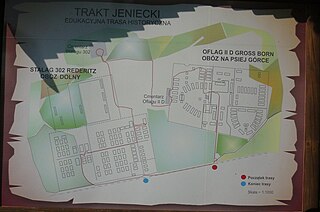
Oflag IV-B Koenigstein was a German POW camp for Allied officers during World War II. It was located in Festung Königstein near the town of Königstein in Saxony.

Oflag II-D Gross Born (Grossborn-Westfalenhof) was a World War II German prisoner-of-war camp located at Gross Born, Pomerania, near Westfalenhof (Kłomino). It housed Polish and French officers.

Wiktor Thommée (1881–1962) was a Polish military commander and a brigadier general of the Polish Army. A veteran of the Great War and the Russian Civil War, he is best known for his command over Piotrków Operational Group and the battle of the Bzura during the Invasion of Poland of 1939.

Oflag VI-B was a World War II German prisoner-of-war camp for officers (Offizerlager), 1 km (0.6 mi) southwest of the village of Dössel in Germany.
Oflag IX-C was a German prisoner-of-war camp for officers (Offizierlager) during World War II, located just to the south of the village of Molsdorf, near Erfurt in Thuringia.

Oflag XII-B was a German World War II prisoner-of-war camp for officers (Offizierlager) located in the citadel of Mainz, in western Germany. The fortress had also served as an Oflag in World War I.
Oflag VII-B was a World War II German prisoner-of-war camp for officers (Offizierlager), located in Eichstätt, Bavaria, about 100 km (62 mi) north of Munich.

Stalag VII-A was the largest prisoner-of-war camp in Nazi Germany during World War II, located just north of the town of Moosburg in southern Bavaria. The camp covered an area of 35 hectares. It served also as a transit camp through which prisoners, including officers, were processed on their way to other camps. At some time during the war, prisoners from every nation fighting against Germany passed through it. At the time of its liberation on 29 April 1945, there were 76,248 prisoners in the main camp and 40,000 or more in Arbeitskommando working in factories, repairing railroads or on farms.

Stalag VI-C was a World War II German POW camp located 6 km west of the village Oberlangen in Emsland in north-western Germany. It was originally built with five others in the same marshland area as a prison camp (Straflager) for Germans. From 1939 till 1945 the Oberlangen camp was a Prisoner of War camp.

Camp Fünfeichen was a World War II German prisoner-of-war camp located in Fünfeichen, a former estate within the city limits of Neubrandenburg, Mecklenburg, northern Germany. Built as Stalag II-A Neubrandenburg in 1939, it was extended by the officer camp Oflag II-E in 1940. After the Soviet takeover in 1945 until 1949 it was used as special camp, NKVD-camp Nr. 9 of the Soviet secret service (NKVD). Today, the site of the camp is a memorial.

Oflag IV-C, often referred to by its location at Colditz Castle, overlooking Colditz, Saxony, was one of the most noted German Army prisoner-of-war camps for captured enemy officers during World War II; Oflag is a shortening of Offizierslager, meaning "officers' camp".

Oflag 79 was a German World War II prisoner-of-war camp for Allied officers. The camp was located at Waggum near Braunschweig in Germany, also known by the English name of Brunswick. It was located in a three-story brick building that had previously been the home of a German parachute regiment, near the Hermann Göring aircraft engine factory.

Oflag X-C was a German World War II prisoner-of-war camp for officers (Offizierlager) in Lübeck in northern Germany. The camp was located on the corner of Friedhofsallee and Vorwerkstrasse, close to Lübeck's border with the town of Schwartau, and is often cited as being located in Schwartau rather than Lübeck.

Stalag XVIII-A was a World War II German Army (Wehrmacht) prisoner-of-war camp located to the south of the town of Wolfsberg, in the southern Austrian state of Carinthia, then a part of Nazi Germany. A sub-camp Stalag XVIII-A/Z was later opened in Spittal an der Drau about 100 km (62 mi) to the west.
Oflag V-B was a World War II German prisoner-of-war camp for officers (Offizierlager), in operation from 1940 until 1942. It was located in Biberach in south-eastern Baden-Württemberg.

Szubin is a town in Nakło County, Kuyavian-Pomeranian Voivodeship, Poland, located southwest of Bydgoszcz. It has a population of around 9,300. It is located in the ethnocultural region of Pałuki.

Oflag 64 was a World War II German prisoner-of-war camp for officers located at Szubin a few miles south of Bydgoszcz, in Pomorze, Poland, which at that time was occupied by Nazi Germany. It was probably the only German POW camp set up exclusively for U.S. Army ground component officers. At most other camps there were several nationalities, although they were usually separated into national compounds.

Oflag XXI-B and Stalag XXI-B were World War II German prisoner-of-war camps for officers and enlisted men, located at Szubin a few miles southwest of Bydgoszcz, Poland, which at that time was occupied by Nazi Germany.

Oflag XXI-C was a German Army World War II prisoner-of-war camp for officers (Offizierlager) located in Ostrzeszów in German-occupied Poland. It held mostly Norwegian officers arrested in 1942 and 1943, but also Dutch, Italian, Serbian and Soviet POWs. Originally most Norwegian soldiers and officers had been released after the end of the Norwegian campaign, but as resistance activities increased, the officers were rearrested and sent to POW camps.

Nazi Germany operated around 1,000 prisoner-of-war camps during World War II (1939-1945).
















